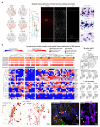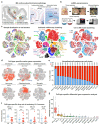Neuronal vulnerability and multilineage diversity in multiple sclerosis
- PMID: 31316211
- PMCID: PMC6731122
- DOI: 10.1038/s41586-019-1404-z
Neuronal vulnerability and multilineage diversity in multiple sclerosis
Abstract
Multiple sclerosis (MS) is a neuroinflammatory disease with a relapsing-remitting disease course at early stages, distinct lesion characteristics in cortical grey versus subcortical white matter and neurodegeneration at chronic stages. Here we used single-nucleus RNA sequencing to assess changes in expression in multiple cell lineages in MS lesions and validated the results using multiplex in situ hybridization. We found selective vulnerability and loss of excitatory CUX2-expressing projection neurons in upper-cortical layers underlying meningeal inflammation; such MS neuron populations exhibited upregulation of stress pathway genes and long non-coding RNAs. Signatures of stressed oligodendrocytes, reactive astrocytes and activated microglia mapped most strongly to the rim of MS plaques. Notably, single-nucleus RNA sequencing identified phagocytosing microglia and/or macrophages by their ingestion and perinuclear import of myelin transcripts, confirmed by functional mouse and human culture assays. Our findings indicate lineage- and region-specific transcriptomic changes associated with selective cortical neuron damage and glial activation contributing to progression of MS lesions.
Conflict of interest statement
The authors state no relevant competing interests or disclosures.
Figures











References
-
- Collaborators, G. D. a. I. I. a. P. Global, regional, and national incidence, prevalence, and years lived with disability for 310 diseases and injuries, 1990-2015: a systematic analysis for the Global Burden of Disease Study 2015. Lancet. 2016;388:1545–1602. doi: 10.1016/S0140-6736(16)31678-6. - DOI - PMC - PubMed
MeSH terms
Substances
Grants and funding
- R01 NS040511/NS/NINDS NIH HHS/United States
- G0300336/MRC_/Medical Research Council/United Kingdom
- G0701476/MRC_/Medical Research Council/United Kingdom
- U41 HG002371/HG/NHGRI NIH HHS/United States
- R35 NS097305/NS/NINDS NIH HHS/United States
- MR/K008803/1/MRC_/Medical Research Council/United Kingdom
- G0802545/MRC_/Medical Research Council/United Kingdom
- MR/M010503/1/MRC_/Medical Research Council/United Kingdom
- MC_PC_12009/MRC_/Medical Research Council/United Kingdom
- 108139/WT_/Wellcome Trust/United Kingdom
- F32 NS103266/NS/NINDS NIH HHS/United States
- G0300338/MRC_/Medical Research Council/United Kingdom
- G0700392/MRC_/Medical Research Council/United Kingdom

